Introduction
For this work, the most appropriate date is May because it surrounds the ending of the hedge. For this question, the portfolio is already structured at the time identified as the matter dictates. Consequently, the position of the equity would be 24×1000= 29000 because the date of birth in use is 29/02/1992. Nonetheless, the value of the value of my position is worked out by multiplying the equity position which is 29000 by FTSE 100 index 6104.19 thereby resulting to 24000*6104.19= 168236220.79
Explain the advantages and disadvantages of using options to hedge this scenario compared to using futures only.
Risk and its management is part of any activity involving economy mostly when dealing with bigger financial institutions. Nonetheless, there are several ways of reducing in these systems including Hedging. Hedging has both advantages and disadvantages in comparison to using future regarding this scenario. To quote, other means are very expensive in gaining access to underlying investment without purchasing stocks, through this; writer enjoys an advantage because there is no need to make a delivery at the expiry of the option (Cooper & Kaplanis 1994, p. 45). Using hedge, there is a higher ability to reduce loss during the shell offs. For example, in the month used in the portfolio, there is a very minimal loss of funds as opposed to when they other methods. This is imperative for the improvement of portfolio risk profile, therefore, making hedge the most successful means of risk reduction.
Consequently, this method is the best way of capital preservation for this scenario. Traditionally, managers tend to view risks in terms of performance deviation (Engel & Matsumoto 2009, p. 47). Further, the system of hedging makes the terms of exchange standard and all the stakeholders involved benefit from the standardization. In regards to this case study, the method of hedging is beneficial because it limits losses. However, it brings advantage because investors are at liberty to chose the side of the trade they view to have very limited financial insecurity. Another key importance of hedging in this scenario is the fact that it is instrumental in reimbursing the return of the portfolio. Another positive side of the hedging is the diversification in that one is capable of copying the system into other similar investments and the results will still depict the reduction of the losses.
Choices and prospects contracts are comparative. Both speak to activities that happen later on. Prospects markets are contracts to either acknowledge or convey the real physical item, while a choice contract is a contract on the fundamental prospects contract. Choices contracts give the agriculturist the privilege, however not the commitment, to purchase or offer a hidden product. This basic item is a fates contract. Due to these similarities and the way that alternatives depend on a prospects contract, makers may scrutinize the benefit of utilizing an alternatives contract (Engel & Matsumoto 2009, p. 48). To settle on a choice between utilizing a prospects contract or an alternatives contract, makers need to assess both options.
In comparison with futures, options have no significant margin calls; in addition, they also have the ability to take advantage of favorable price moves (Engel & Matsumoto 2009, p. 50). Options also have limited risk. Similarly, futures also have significant advantages over options. With futures associated with the future market contracts, there are no premium charges.
Both options have a number of disadvantages. The plan requires an initial payment of premiums. The future positions will be involved with all its financials and contract obligations if execution of an assumed option applies. Finally, with options, the premiums might not be able to move with options, rather with the futures. Contracts on the other hand move with the delta effect.
Nonetheless, the system is not only advantageous; there are disadvantages arising from hedging as shown in this scenario. In cases where the risk involves the ability of quick sales of stocks to get liquid cash, the fund manager will face uphill because some of the stocks may not immediately sell into cash, in this scenario; some of the investors are not easy to convince that this system is of any advantage at all. Further, this system is faced with regulatory framework and therefore, it may block the excessive spread of risks. Additionally, the investors may miss in the timing of the peak of the stock making the effort to improve portfolio return be of less significance. Additionally, this system has no parameter set to tackle systematic risks and therefore it is not suitable for such risks. Another disadvantage facing hedging is the cost of incurring such service. The high fees that come with it in most cases is the reasons why fund manager do tend to object this system at the same times the risks are always not looked at in the adjustment of risk (Black 1989, p. 16).
Explain and discuss how a zero-cost collar could be used in this scenario. Give an example using current options prices.
According to Bodie (1976, p. 460), Zero Cost Caller is crucial concerning interest rates. Through this, the parties involved must agree to either purchase or dispose the existing assets at the outlined market price and within the set date in the future. This is done because the investors aim at protecting themselves against any risk coming with an investment such as lack of steadiness in the prices of the security. For instance, this scenario depicts that between the periods of August and September investors may choose to either sell or buy goods depending on his relations, whether long or short. During the short positions, the investor has the option of selling as opposed to long seasons where the available option is to buy the existing assets at the set prices. Consequently, the month of May is the most desired because of running out date is close to the final submission date.
Confirm your result using the OSA (Option Scenario Analysis) or OVME function on Bloomberg.
In most cases, investors do hedge just a portion of the equity positions because excessive hedging scales down the possibility of increased gaining. Therefore, this means that the investors hedge part of the equity positions to minimize the loss in the event of any calamity resulting to the loss.
Therefore, this working gives the number of contracts in the portfolio.
Where
VA = the value of the portfolio= 168236220
β= is beta
VF =is the value of one futures contract =6185
This working is done with the use of the first computation using the date of the birth and because the portfolio is index, the value of beta is one therefore the workings will be of this format.
168236220=27200.68
This therefore means that the number of future that should be bought is 27200.7
Option Scenario analysis functions show that 24000 unit of future of FTSE 100 that will be required 27200 this is the point that will have no risk or very minimal risk. Below is the illustration of the product of the Option scenario analysis.
Show and explain the effect of your hedge on the profit and loss of your portfolio in different market scenarios. Show screencasts of your results.
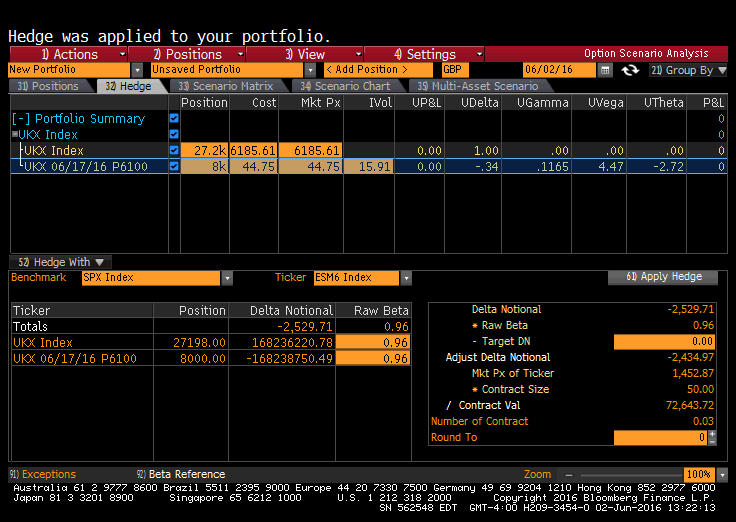
Option Scenario Analysis only covers 85% of security investment portfolio equivalence of the hedge ratio, to mean the rest of the 15% will remain uncovered.
The graphs show the profit and loss of both the hedge and un-hedged positions.
Scenario matrix hedge
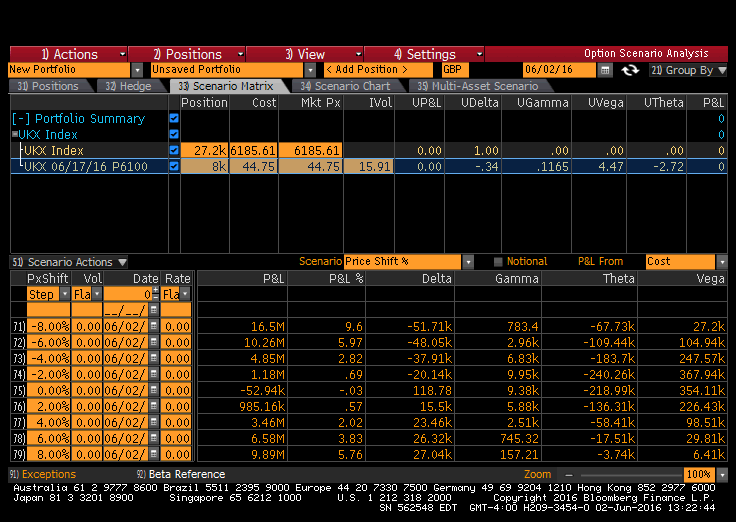
Scenario matrix un-headed
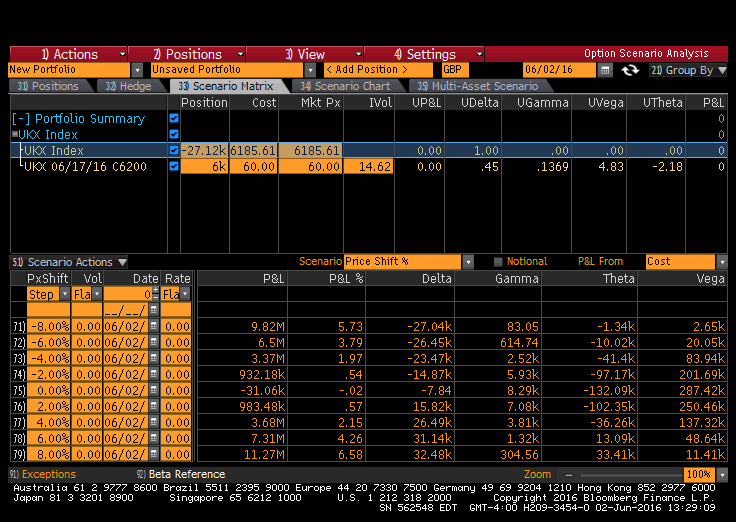
According to this evaluation, it is clear that un-hedged position return as shown by profit and loss is very unpredictable. For instance, at the rate of -8% the investment produces an income of 16.5 million the same as the profit generated. Therefore, causes the possibility of high loss 16.5 million. Separately, the hedge position shows a very minimum range close to constant at 27.1k resulting to the weak lower hedged position. Hedge moderate the loss that would have been incurred is 16.5 million but only 27.1 thousand is lost.
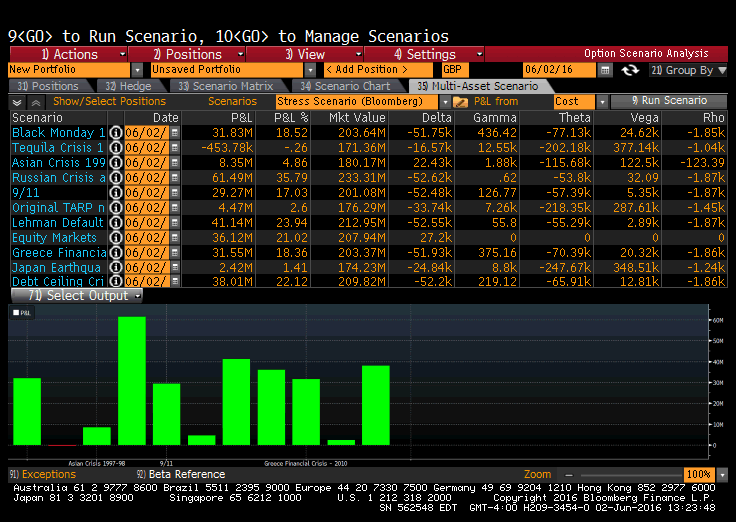
Multi asset scenario hedged
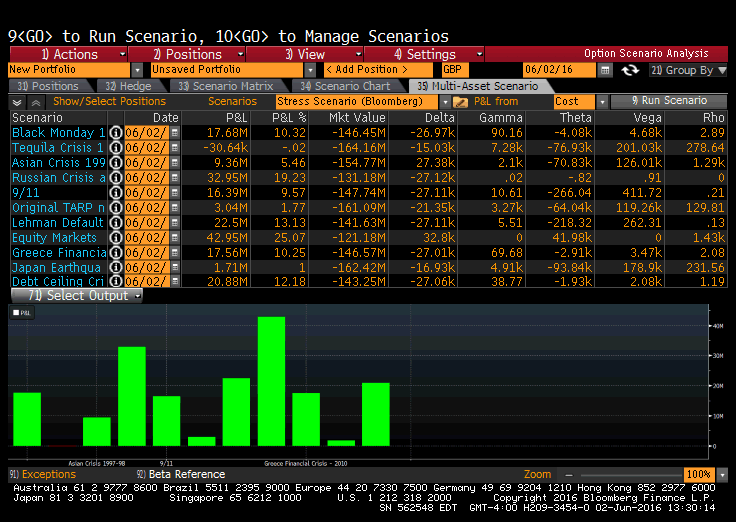
The figures confirm that hedge help to mitigate on the possibility of incurring any loss. An example illustration of black Monday where 31.8 million could lose, only 17.8 million will get lost, a confirmation that hedge is instrumental in risk reduction.
Making reference to academic literature and recent events on financial markets, discuss the use and limitations of the Black-Scholes Option Pricing Model.
Even though Black Scholars model is highly regarded and used in financial markets, limitations are facing the theory. These include volatility, a forecast of the expected value of the stock in the future (Agarwal & Naik 2004, p. 68). Though the forecast can be accurate shortly, it contains some elements of inconsistency in the end. This system results to volatility clustering, which is a result of; enormous charges for the huge amount of money, and small fees for the little sum of money and vice versa (Lynch 2001, p. 120). These measures have negative correlations with assets and pricing returns, which are equally accurate over a very short period. In the same line, Black scholar model lacks the capability to predict an individual market or direction of the market. According to this theory, there is an assumption of regular unit by which, stocks left either increase in price or reduces. According to Glen and Jorion (1993, p. 1886), this theory is false because several economic factors are determining fluctuation of stock prices in the market. At the sometimes, amount of stock at any given time is independent of any stock in the future times. Moreover, this theory depicts that returns from assets have defined variance and trail, which contradicts stable distributions witnessed in the logs and heavy trails. It also offers a scale time, which helps in the calculations of assets increase. However, these assumptions are purely theoretical and do not relate to the real life situation (Bessembinder 1992, p. 640).
In the same fashion, there are other underlying limitations of Black scholar theory. It suggests that the same way like with volatility, the interest rate of the stock are constant and are known to all the stockholders. The method used is risk-free and does not account for any either risk that may lead to increase or reduction of the interest. According to the theory, dividends are not titled to any benefit during the option life of stock, a contradicting fact because most of the world recognized companies have provisions for individual benefits during the option’s life through adjustments made in the equity markets. Concurrently, this theory does not provide provision for commission and any cost charged in transactions. It assumes that there are no charges levied on the buying or selling of the stock, however, each time one does a transaction, there is tax charged for example charges levied by stockbrokers.
Finally, the theory of Black scholar is criticized for its assertion that there is liquidity in the market and one purchase amount of stock any given time without any constraint. This is so inaccurate because there are set regulatory or extend at which investors are capable of spending their cash as well as policies established by the company to the extent of stock to be either purchased or sold. However, to curb the limitations outlined, markets should set an explicit parameter aimed at harmonizing the challenges and coming with the most appropriate method of risk reduction (Black, & Litterman 1992, p. 28).
Are there any additional risks and considerations to be taken into account when using options to hedge a portfolio in a situation like this? Discuss, making reference to academic literature.
According to Scott and Peterson (1986, p. 326), there are several factor and risks put in place while using hedging as a means of risk reduction. For instance, transparency is a necessary element in this method. This approach is deemed less transparent for example in public equity or debts funds, real estate funds or even private equity funds. This is because funds manager in most cases withhold information of what the investors money does, they have not a single idea except the position of their money.
Further, the amount of money to be protected from the risk is a factor in picking this method as a way of risk reduction (Scott & Peterson 1986, p. 326). For example, managers are instrumental in the service delivery to the market while the investors are helpful and ready to pay for the services offered. In this reason, an investor keeps his investments in a way whereby the burden of incurring the impending eventuality spread across to other fields. Further, it is argued that this system is very instrumental to the manager at the expense of investors. This is because there are no separate accounts used for keeping the cash but consolidated ones in the mind of the assets protected. Consequently, other methods such as lockup periods, side pockets, and rule which limits the clients in getting access to their cash but giving the manager an opportunity to pick the investment to put in place. Because the fund manager manages the fund, hedging makes clients not interested in what their funds do.
Other factors include; investment structures, for instance, making diversified investments comes with the very best way to determine if the amount protected against the risk will bear more fruits. The reason for this is that the cash is not only protected against the danger but has some financial benefits subjected to the shareholder at the time the stock are mature (Brandt, Santa-Clara, & Valkanov 2009, p. 3420). Further, to pick a method of hedging, it is important to think in the direction of objectives through this, that the manager entrusted with the mandate to safeguard the funds should have the most appropriate experience and qualifications. Similarly, it is important to check the record if the company entrusted with the responsibility to protect the cash from any risk. Some institution has bad records of mismanaging investor’s investments. Finally, it is important to consider the amount the company spends on its operation. If it is too much, there is the likelihood of mismanagement of the cash as well.
References
Agarwal, V & Naik, NY 2004, ‘Risks and portfolio decisions involving hedge funds’, Review of Financial studies, vol. 17, no. 1, pp. 63-98.
Bessembinder, H 1992, ‘Systematic risk, hedging pressure, and risk premiums in futures markets’, Review of Financial Studies, vol. 5, no. 4, pp.637-667.
Black, F & Litterman, R 1992, ‘Global portfolio optimization’, Financial analysts journal, vol. 48, no. 5, pp. 28-43.
Black, F 1989, ‘Universal hedging: Optimizing currency risk and reward in international equity portfolios’, Financial Analysts Journal, vol. 45, no. 4, pp. 16-22.
Bodie, Z 1976, ‘Common stocks as a hedge against inflation’, The Journal of Finance, vol. 31, no. 2, pp. 459-470.
Brandt MW, Santa-Clara P, & Valkanov 2009, ‘Parametric portfolio policies: Exploiting characteristics in the cross-section of equity returns’, Review of Financial Studies, vol. 22, no. 9, pp. 3411-3447.
Cooper I & Kaplanis, E 1994, ‘Home bias in equity portfolios, inflation hedging, and international capital market equilibrium’, Review of Financial Studies, vol. 7, no. 1, pp. 45-60.
Engel, CM & Matsumoto, A 2009, ‘The international diversification puzzle when goods prices are sticky: it’s really about exchange-rate hedging, not equity portfolios’, IMF Working Papers, pp. 1-47.
Glen, J & Jorion, P 1993, ‘Currency hedging for international portfolios’, The Journal of Finance, vol. 48, no. 5, p. 1865-1886.
Lynch, A W 2001, ‘Portfolio choice and equity characteristics: Characterizing the hedging demands induced by return predictability’, Journal of Financial Economics, vol. 62, no. 1, pp. 67-130.
Scott, WL, & Peterson, R L 1986, ‘Interest rate risk and equity values of hedged and unhedged financial intermediaries’, Journal of Financial Research, vol. 9, no. 4, pp. 325-329.